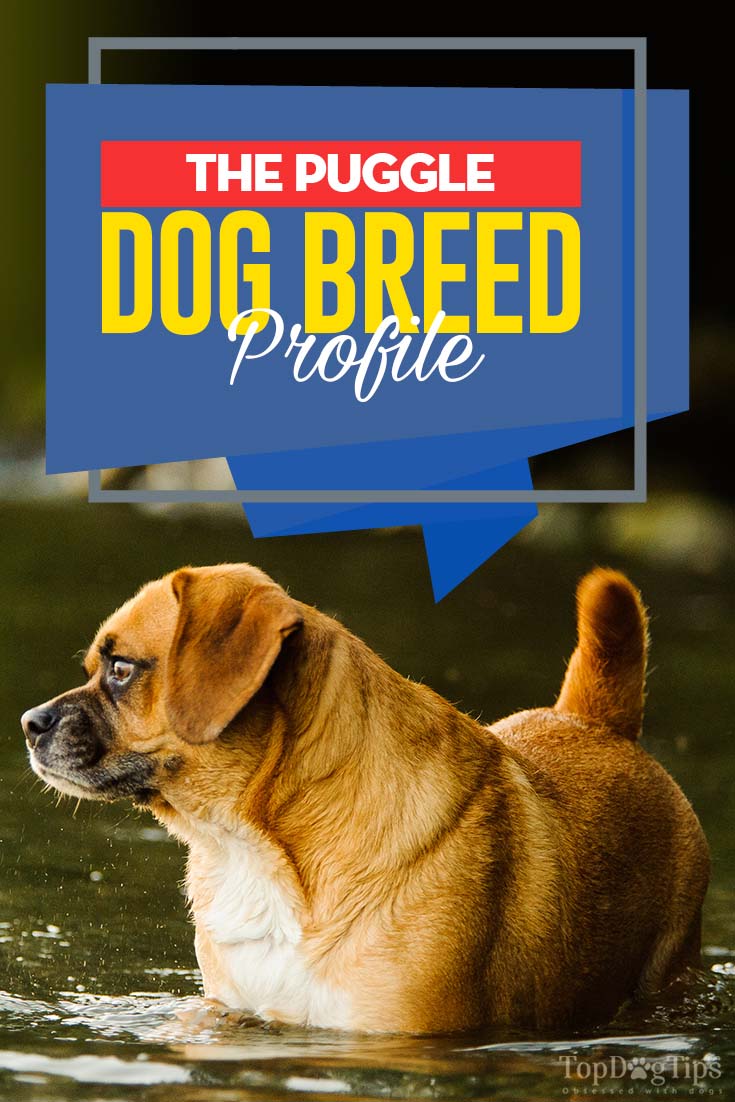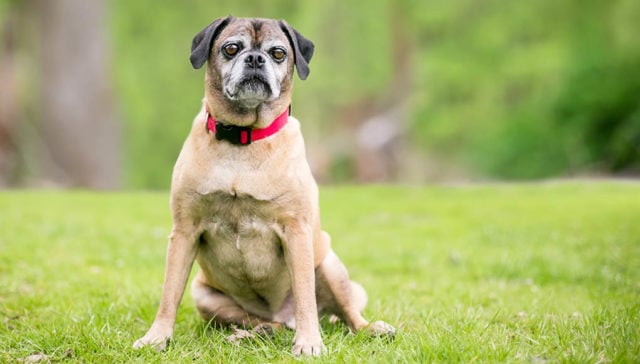
Table of Contents
The Puggle dog breed is one of the most popular designer crossbreeds in the United States.
Puggles is a cross between the Beagle and Pug breeds. Usually, Puggle puppies are the offspring of a male pug and a female beagle.
They're slowly gaining popularity due to their loving behavior and adorable looks.
They are good-natured and friendly dogs. These intelligent dogs do good with kids and other dogs, making them great family pets.
Read on to learn more about this cute and popular dog!

Meet the Puggle's Parents
As you are considering adopting or purchasing a Puggle, reviewing the parents is a good idea.
Your hybrid will inherit some of the traits from each parent. It is most common for a Beagle to be the mother, while the father is usually a Pug.
If it is the other way around, there are usually complications since a female pug is too small for birthing.
These are some of the possible traits your Puggle may inherit from his parents:
Pug
- This temperamental cutie doesn’t require a backyard, so apartment dwellers need not despair.
- The short coat makes them simple to brush and keep clean.
- Beware: Pugs shed a lot, so you can expect to vacuum or sweep often.
- The perky Pug is super friendly and makes for an ideal companion.
- They are stubborn. Training can, therefore, be rather tricky. A lot of patience is necessary.
- The distinguishing pushed-in face causes breathing problems. This can even cause vomiting, excessive drooling, or coughing when they are eating or drinking. Furthermore, this means that they snort, wheeze, and snore. They also struggle to keep cool despite their short hair because it is difficult to pZZant.
- Pugs can develop several eye disorders because of their prominent, bulging eyeballs. The most likely are cherry eye, eyelid entropion, cataracts, Progressive Retinal Atrophy (PRA), dryness, and irritation.
- Risks shared with the Beagle include idiopathic epilepsy and hip dysplasia.
- Food cannot be resisted. The greedy Pug will eat as much as he can and is prone to obesity if not kept in check.
READ MORE: Pug Dog Breed Profile
Beagle
- A backyard with a high fence is a must, as these dogs have an incredible sense of smell and will often wander off when following their noses. They are notorious for digging under fences to find the source of whatever scent they find appealing.
- The beagle has a short-haired coat, which makes grooming a breeze. In winter, the Beagle’s coat thickens. They continue to lose hair all year round, but shedding is at its maximum in the spring.
- The cheerful Beagle gets on with everyone, including children, strangers, and other dogs. For this reason, they do not make the best guard dogs.
- This breed is renowned for being hardheaded, and they may purposefully ignore you if they feel it. These dogs aren't the greatest option for a first-time owner, as they require a trainer with experience.
- The Beagle may have several eye-related issues, such as glaucoma, distichiasis, cherry eye, and Progressive Retinal Atrophy (PRA) that can ultimately cause blindness.
- Like the Pug, there is also the possibility of hip dysplasia and idiopathic epilepsy.
- Beagles adore food, too, so watch what they eat, as they can easily become overweight.
- Exercise is important because these canines have quite a high level of energy.
READ MORE: Beagle Breed Profile
However, it's possible that the Puggle dog breed, as a crossbreed, may or may not develop some features from either of the parents.
This also depends on individuality.
For example, a Puggle litter may all look completely different from each other, so it is truly hard to say what the outcome will be.
Puggle Dog Breed History
While not all designer dogs have been well-documented throughout history, the Puggle is one of the few with well-known roots.
According to PetGuide, the first Puggle originated in the U.S. in the 1980s. A lot of people believed that the first Puggles were the result of accidental breeding.
However, Puggle enthusiasts claim they originated from planned breeding intending to create a new breed.
Wallace Havens, a Wisconsin breeder, produced the first litter of the Puggle mixed breed.
Over the years, this breed has gained popularity all over the United States, and in 2005, Puggles became the most widely owned crossbreed dog in history.
Although not recognized by the American Kennel Club, Puggle breeders have worked hard to create a more standard look and temperament for this crossbreed.
Breeders also have high hopes that the AKC will recognize Puggle in the future.
On the other hand, the Puggle dog breed is recognized by other national and international clubs, including the American Canine Hybrid Club and the International Designer Canine Registry.
Physical Characteristics of a Puggle
Puggle groups and breeders have nicknamed this dog the ‘miniature Mastiff.' And that's actually a pretty accurate description of what they look like.
Like the Pug, the Puggle dog breed has a wrinkled forehead and face.
The nose is still squished, but the snout is slightly longer.
Some Puggles tend to snort and snore as well. Their sense of smell remains incredible, an inherited trait from the Beagle side.
These dogs have full-barreled, stout bodies with short legs, floppy ears, and an interesting tail. Their tail has the tight curl of the Pug, but it is longer and usually white like the Beagle.
Keep in mind that Puggles tend to get bigger than initially expected.
But don't worry, they're still considered a small breed. But while they may be small, they are also quite sturdy.
This means they tend to be quite heavy, so you may not want to tote them around in a purse or carrier.
Size
Generally, Puggles are 13 to 15 inches tall at the shoulder. Toy-sized Puggles, however, are less than 13 inches tall.
On the other hand, most puggles weigh around 18 to 30 pounds, and toy-sized poodles weigh 8 to 17 pounds on average.
Coat Color
This crossbreed has a short and smooth double coat. Their undercoat is short and dense, and a slightly longer topcoat covers it.
It's common for Puggles to have black masks on their faces. And a Puggle's coat color can vary depending on the mixture of their parents.
Common coat colors include fawn, red, tan, lemon, black, or any of these colors with white.
And since Puggles are double-coated, they tend to shed a lot and should be brushed at least once a week to remove excess fur.
Puggle Temperament
Once again, this will differ from Puggle to Puggle.
The idea with the mix-and-match breeding was to have a pup with the Pug’s more laid-back approach to life, which should curb the wandering traits of the sharp-nosed Beagle.
Unfortunately, this doesn't work for every Puggle, as they develop their individual personalities.
But Overall, you are looking at a playful, lovable, social, enthusiastic, and 100% cute pooch.
Puggles are loyal and affectionate dogs, even though they are active.
They also love to just cuddle up on the sofa or your bed. These dogs thrive on attention and affection as they enjoy spending time with their owners. Puggles also get along well with kids and other pets.
And the bonus? These pups have quite a sense of humor, and you'll find yourself laughing a lot at their antics.
However, if your Puggle is not getting enough exercise, it can result in behavioral problems like howling, barking, digging, or wandering.
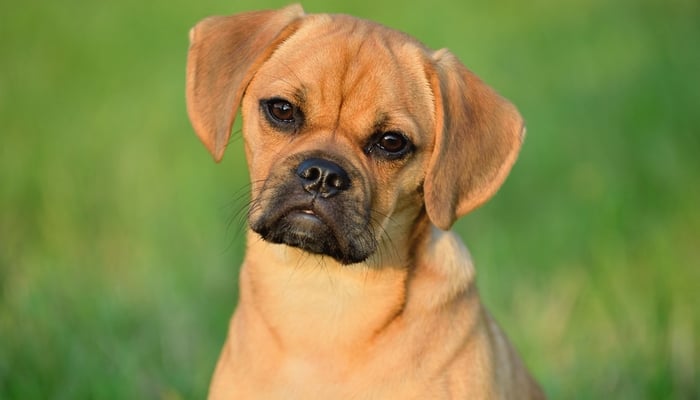
Living with a Puggle
Puggles are generally indoor dogs. In fact, they should live indoors with the family and not outside.
They can easily adapt to any living situation. So you don't have to worry about living in the city or a small apartment.
As long there's enough space for them to do zoomies around, then you are meeting the required exercise your pup needs.
They love the company of their owners but can do okay on their own as long as they get plenty of exercise and have toys that can keep them entertained.
Also, Puggles are decent watchdogs. They tend to bark at strangers that are approaching your home.
But they are not the best guard dogs as they can be a bit too friendly and easy-going.
They like sitting on your lap, cuddling, and lavish in attention. The result is that some of these canines can suffer from separation anxiety if left to their own devices for an extended period of time.
As they are smart, this means they can get bored easily.
In this case, they will find innovative means to keep themselves occupied.
Common behavior issues often found with the Puggle dog breed include chewing, digging, or sniffing out food.
Who Would Be a Suitable Puggle Owner?
Simply put, anyone would be a good fit for a Puggle.
Families with children, folks who live alone or in a city apartment with no yard, the elderly, and even first-time dog owners can handle this breed.
Puggles are indoor dogs, affectionate, loyal, and bond strongly with their humans.
This is why they make fantastic family pets, as they will adore each and every one in the family.
Their laid-back nature and sturdy build make them a good fit for families with children as well.
Training
Although the Puggle is lovable, they are unquestionably willful and free-spirited.
This can sometimes be amusing if they pretend not to hear you, but it could present a real issue to an impatient trainer.
Just like all dogs, Puggles are needed to be trained for socialization at an early stage.
Exposure to different surroundings, people, and other pets at a young age can help your puppy grow into a well-rounded dog.
These dogs might be intelligent, but they are a bit stubborn. That's why it's best to train your dog using positive reinforcement techniques.
For instance, if they obey or do something good, reward them with treats, play, and praise.
Due to their super noses, these dogs get easily distracted if they catch the whiff of something appealing.
It is best that training sessions are entertaining and keep their attention. Make it fun, rather than something boring and tedious, to keep them in the moment.
As with any breed, training no-nos include:
- shouting at your dog
- aggressive techniques such as electronic collars, choke chains, head collars, and spike collars
- forcing your dog to do things he is not comfortable with
Exercise
Just like any other dog, exercise is crucial. Exercise can help them burn off excess energy and keep them physically and mentally healthy.
Puggles have moderate energy levels and require a minimum of one hour of proper exercise per day. It does not need to be all at once, so a 30-minute walk in the morning and a 30-minute walk at night is just fine.
As the pet owner, you must make sure you'll be walking your dog with a leash and playing with them in a secured area.
As we've discussed earlier, Puggles tend to inherit their parent's personalities, and in some cases, Beagles sometimes ignore their owner's commands when they've picked up an intriguing scent, which Puggles may sometimes do.
While the Puggle dog enjoys being outdoors, keeping them leashed is best.
Their Beagle side may decide to dash off if they smell something enticing. This trait also makes for a bad jogging partner, as they will always want to stop and sniff.
If these dogs do not expel their energy, they will find alternative means to get rid of it.
You may not always like the result, as they are known to chew belongings and dig holes in the yard.
If you are into dog sports, the Puggle is great for agility routines
Remember, if your Puggle is more Pug-like, he will have a much lower energy capacity.
Grooming
Puggles may have trouble facing their grooming routine. The best suggestion will be early exposure and positive association.
Owners should hold their paws, their mouths or teeth, and their ears casually as much as possible.
If your Puggle sees that the action is harmless, they’ll react less negatively to it. And when they get used to it, grooming may be more effortless.
Still, you need to know that this requires great patience for both the owner and the dog.
The grooming routine is best done after your Puggle is worn out after playtime and their meal. This is when they are most relaxed.
After or during grooming routines, it’s best to have a treat set aside so they’ll recognize that the activity is beneficial for them as well.
Coat Care
Although the Puggle has short hair, it is a double coat. Which means they do shed quite a good deal.
The inner coat is smooth but dense, while the second layer is much longer and finer.
Brushing at least twice a week or more is necessary to help reduce dead hair and grime, allowing the newer coat to grow. It also helps regulate natural oil in their skin and coat for a healthier texture and shape.
On the other hand, bath time may be done at least twice or thrice a month.
Fortunately, this crossbreed's double coat helps repel grime and dirt. However, it’s still best to rinse them after swimming out or after a muddy walk.
Remember to thoroughly lather the folds of their skin and dry them completely after A bath.
Drying prevents any infection or host of bacteria from breeding in their skin fold, especially since they're prone to hot spots.
Ears and Eyes
Another regimen we should carefully watch with Puggle is grooming their ears.
Unlike Pugs, who have smaller ears that flop, Puggle inherited the Beagle’s ear, which is quite large, heavy, and thick. It may be too hard for them to dry it themselves.
Make sure to clean the Puggle’s ears after a bath or when it gets wet. It’s important to dry it completely.
Moisture and build-up grime is a big factor in infections. And the ears are no stranger in this scenario.
Your Puggles' eyes may also seep occasionally, but you can just wipe this wet cloth.
Teeth
Puggles need to brush their teeth at least once or twice a week. This may require early exposure as not all dogs like their teeth being brushed.
Puggles are a bit prone to tartar, so brushing and dental bites and chews can help the build-up gradually instead.
Nails
Your dog’s nails may naturally get worn down, particularly if he walks on pavement or concrete a lot.
A good rule of thumb is that if you can hear your furry friend click-clacking when he walks on hard surfaces, then his nails are too long.
They have the nails of the beagle, and that means it’s bigger and grows faster. You should trim them at least once or twice a week.
You can also file it instead if the length is not that much.
This is good for your dog in preventing infections of the sensitive paw area. It's also beneficial so his nails don't get ripped off should they get caught on something.
For more detailed information on these specific dog grooming tasks, you can check out Top Dog Tips' helpful video grooming guides, including:
- How To Stop Dogs From Shedding
- How To Bathe A Dog
- How To Brush A Dog's Teeth
- How To Clean A Dog's Ears
- How To Clean Dog Tear Stains
- How To Cut A Dog's Nails
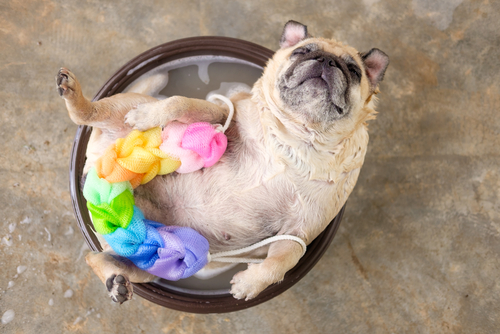
Puggle Health
The Puggle dog breed has an average lifespan of between 10 and 15 years.
Puggles are quite a healthy breed, but sadly, some may carry inherited diseases from their original breed.
Not all of them carry these diseases, but some may be as sensitive as their origin breed.
Here are illnesses to watch out for:
Cherry Eye
Cherry Eye is an ocular condition where the ligament in the third eyelid that holds the tear duct detaches from the orbital bone.
This causes the gland to prolapse and become visible in the outer eyelid. In its early stages, pain is unnoticeable, but as it is more prominent, pain is evident.
The good news is it's not contagious and not fatal. Just make sure to have your Puggle checked up when they get the cherry eye.
Untreated or prolonged conditions may worsen and develop dry eye and infections in your pet.
Ear Infection
Since the Puggle inherited its ears from their Beagle breed, they’re much bigger and droopier, making it difficult to clean them naturally.
The causes of ear infections may vary, but it’s essential to have them checked during regular veterinarian visits.
If you notice shaking of the head, unpleasant odor in the ears, or overly scratching of their ears, do have them checked immediately.
Heatstroke
One of this crossbreed's origins is the Pug, which is very much heat-intolerant. Sadly, the Puggle may inherit this.
It’s best not to expose the Puggles to a warm climate as they are prone to panting, which may lead to heatstroke.
Hip Dysplasia
Hip dysplasia is a genetic condition wherein the socket of the joint and ball becomes distorted. Puggles are sadly prone to hip dysplasia.
When diagnosed with hip dysplasia, it’s important to keep their weight in the normal range and have them exercise with activities that promote joint therapy.
Veterinarians may prescribe medications and supplements for anti-inflammatory/ pain relievers.
Prevention is the same which is keeping them active but not injuring them as well. A treadmill walk or swimming is perfect for prevention and recovery as well.
Hypothyroidism
Hypothyroidism is the inactive function of the thyroid gland. Metabolism is slowed down if diagnosed.
The immune system attacks the thyroid gland as it does not recognize it. Usually, this is an inherited disorder.
If the Puggles are experiencing lethargy, slow heart rate, weight gain, excessive shedding, and high cholesterol, it’s best to have them tested by the veterinarian.
If Puggles are diagnosed with hypothyroidism, the veterinarian may provide maintenance and recommend a diet. It’s best to have this condition checked and addressed immediately.
Idiopathic Seizures
Idiopathic seizures' causes are unknown, but it is an inherited cognition. Some Puggles may suffer from this condition, and there is no known cure as of now.
Veterinarians may administer anti-seizure medication, but it can only decrease the severity of the seizure.
Make sure to have your Puggle checked immediately to provide the right medication for the condition.
Obesity
Obesity is the excess body fat in dogs. Excessive weight may cause another disease in the dog’s health or may be a symptom of another underlying disease.
Obesity must be addressed immediately. Puggles who are obese must be consulted with the veterinarian for further examination regarding the reason.
If an unbalanced diet is a cause, providing a balanced diet and exercise may be a treatment.
Sadly, some underlying conditions are worse. It’s best to have the dog examined immediately.
Patellar Luxation
Patella Luxation is the patella shifting alignment out of the femur. This can range from high to low levels of luxation, and each requires different treatments.
Symptoms may include skipping and kicking off the leg. It’s best to consult with the veterinarian for treatments, therapies, or procedures required to help Puggles with patellar luxation.
Stenotic Nares
Stenotic Nares means the nostrils are narrowly shaped, making it difficult for air to pass in and through. It is a part of brachycephalic syndrome.
Dogs that have stenotic nares are usually recommended to have surgery to widen the gap for more comfortable breathing.
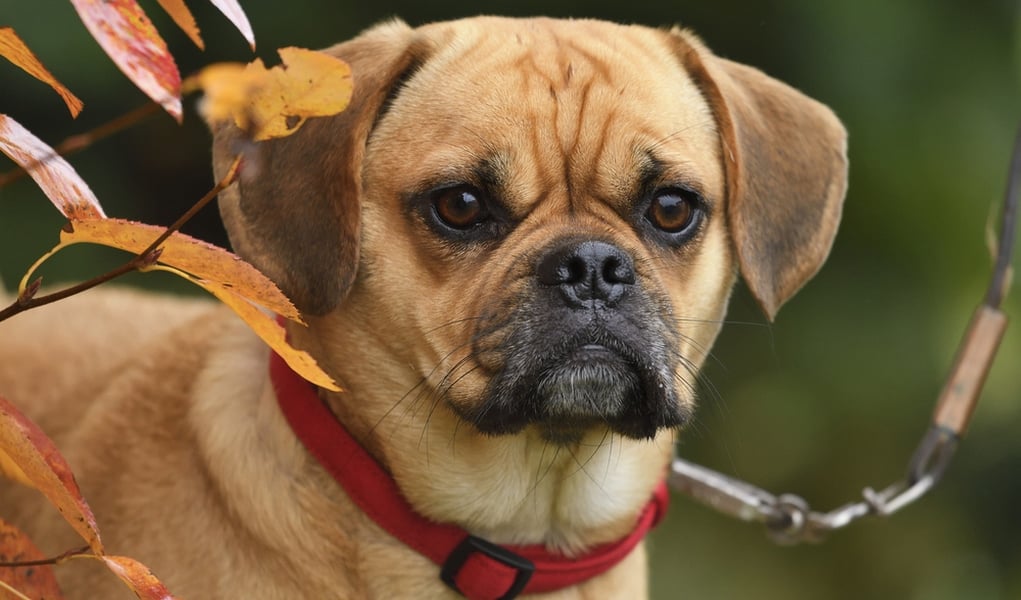
Frequently Asked Questions About the Puggle Dog Breed
Can Puggles be left alone?
Puggles, like both of their origin breed, are quite fond of their companion or family. They cannot be left alone for a long period of hours.
Puggles who are left alone may develop separation anxiety and depression; thus, they will become destructive.
If the owners are planning to leave, they can either leave the Puggle at a daycare or with someone the dog is familiar with as well.
How do Puggles react to other people and pets?
Puggles are extremely welcoming — like both of their parents.
They love to play with children of any age, as this breed is forever young at heart. They are not bothered by screaming or excessive hugging and petting. You will, however, want to supervise them with tiny tots.
Puggles are just as warm towards people that they don’t know, so using them to guard the house is not advisable.
Your Puggle will bark to inform you of a stranger's presence but will greet the intruder warmly while wagging his tail.
Household dogs present no problems for the Puggle. As for other pets, they will get along with these too but may chase smaller animals like cats or rabbits.
This hunting instinct is pure Beagle, but the overall drive for this is a little less with the Puggle dog breed.
Where Do I Get My Puggle?
Both parents of the Puggle must be purebreds, so do your homework and find a reputable breeder.
You can also reach out to rescue groups like Saint's Puggle Rescue.
The fact that the Puggle is a crossbreed means that they are usually more affordable than either of their purebred parents. It is become less rare to have litter produced by two Puggles.
These are called second-generation Puggles and should also be less expensive than first-generation Puggles.
Make sure you ask the breeder about the parents and spend time with mom and dad if possible.
Why does my Puggle stink?
Some Puggles may emit bad smells. The cause may vary from grooming needs to medical reasons.
Try evaluating the Puggle’s skin, especially skin folds, for any moisture, warmth, or unusual texture.
If there are any present, it’s best to consult with your veterinarian to examine the area.
Puggles may need a better grooming regimen due to their thick skin folds, as these areas are prone to infections.
Are Puggles lazy?
Unlike their original breed, the Pug, Puggles are quite energetic. Sometimes, Puggles may begin wandering, digging, and barking when they're bored.
It’s best to satisfy their daily need for physical and mental stimulation.
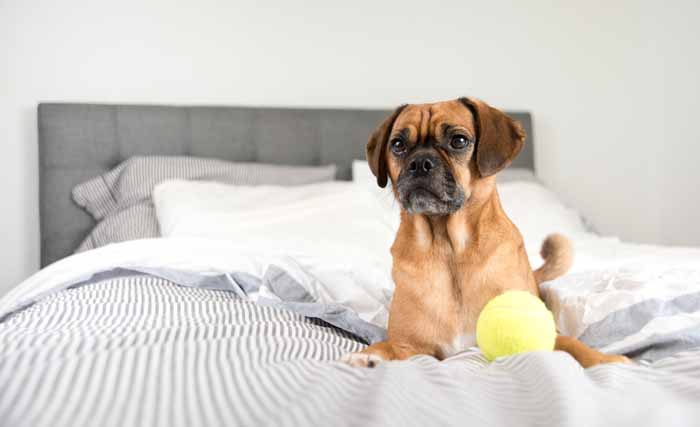
Puggle Dog Breed Summary
If you're fond of mixed dog breeds, one of the cutest and most adorable examples is the Puggle.
They are one of the most popular designer crossbreeds in the U.S.
Puggles are good-natured and friendly dogs, are great companions, and can be the next addition to your family.
They are generally active dogs. They are full of energy, and they love to spend time and play with their owners.
On the other hand, they also love to just cuddle up on the sofa or bed with you.
Have you already got a Puggle? How's your experience? Share it with us in the comments section!
You can also read more mixed-breed profiles by checking out the links below.
Related Articles:
- 25 Best Mixed Breed Dogs to Adopt
- 10 Prettiest Mixed Dog Breeds
- New to Dog Ownership? These Mixed Breeds Are Perfect for First-Time Owners
